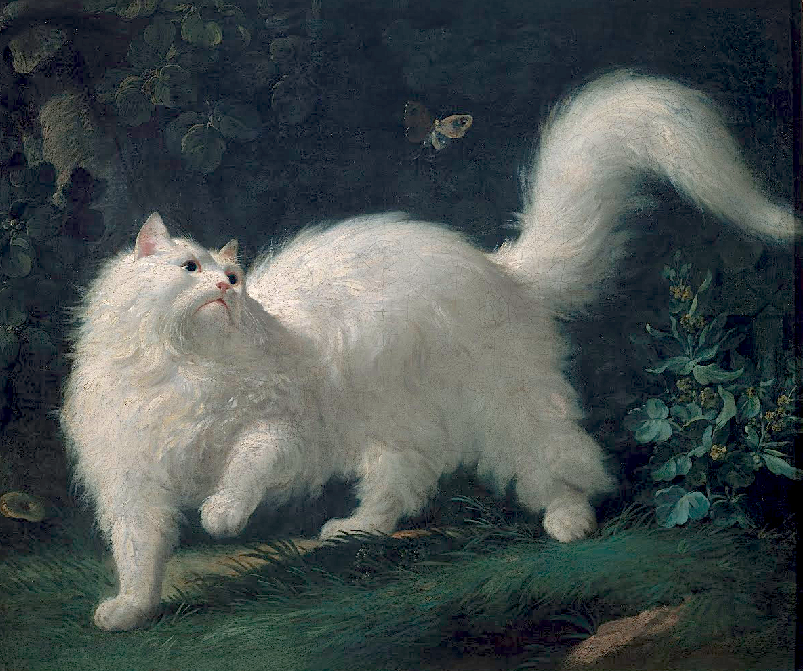Cornelius Visscher’s 1657 engraving, The Large Cat, is grounded, massive, and imperturbable. As for the cat’s failure to attack the mouse, Visscher was said to be inspired by Proverbs 19:15: “Slothfulness casteth into a deep sleep; and an idle soul shall suffer hunger.” Yet, this is hardly a malnourished tabby, while he does look to be an elderly one. I also consider it possible that he’s simply in the REM phase of deepest sleep. This is my favorite cat illustration.
White Angora Cat Chasing a Butterfly, a 1761 painting by Jean-Jacques Bachelier, is sensuality epitomized. Those who read my first post might recall that I consider the Turkish Angora the most beautiful of cats. As thousands of other besotted people have done since their arrival in Western Europe in the 1600s, I regard them as angels with hidden wings. If you will be so kind as to present me with such a cat, Peggy will be less likely to murder me than if I bought one for myself (it is her silly opinion that five cats are more than enough, although she chose four of them), and I promise you that once a Turkish Angora came through the door of this house, no army could take him out again. I told Peggy that I would give her my left eye and my right arm if she would open her heart to a Turkish Angora, but she objected that she has no use for unattached body parts.
The child in Goya’s 1787 painting, Manuel Osorio Manrique de Zuñiga, died four years after his portrait was made. As is often the case in such paintings, Goya’s cat trio portend malevolence, tragedy, and the loss of innocence, this from the vantage point of a species that wages war, runs factory farms, enjoys brutal sports, shoots animals for pleasure, and revels in fictional murders while demonizing animals that must kill to live.
Old Mr. Tombs (by a painter named Ditz) was inspired by George Orwell's 1935 novel, A Clergyman’s Daughter. I see myself in the painting. The year is 2032. My house is cold and poorly lit. I am too weak to read the three remaining books from a library that once contained thousands. Of my scores of potted plants, only a single aspidistra remains, it surviving where nothing else can.* Yet I could afford to live better if I so desired. My cats are my only companions, but I can no longer remember their names. I haven’t peed in days, so I know I will die soon, and my cats will eat my corpse.
M____, from my cat rescue group, is scheduled to drop by in ten days. Meanwhile, the cats will have me to eat. As for water, I had M____ fill every vessel in the house during her last visit, and I have long since arranged my financial affairs so that my cats will live better when I’m gone than they’re living with me here. I am going to close my eyes now, cheered by the thought that my body will soon be incorporated into the bodies of my beloved cats.
“If I die before my cat, I want a little of my ashes put in his food so I can live inside him.”
—Drew Barrymore
*Aspidistras were ubiquitous in the plant-killing atmosphere of gas-lit, coal-heated, heavily-curtained Victorian homes, and their popularity continued through George Orwell’s lifetime (1903-1950). Particularly in Britain, the plant was so beloved that people often had their photos made with it. Because of its popularity, Orwell used the plant to symbolize middle class values in his novel The Flying Aspidistra.




